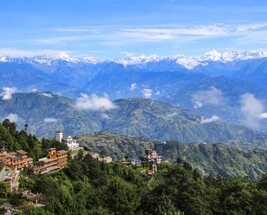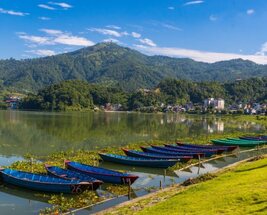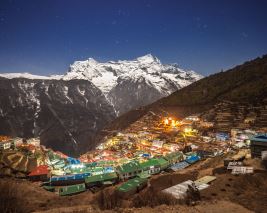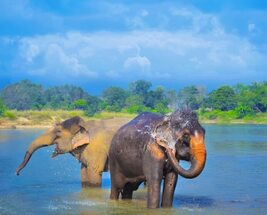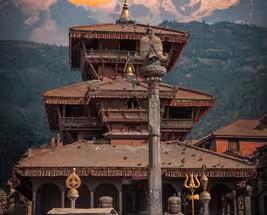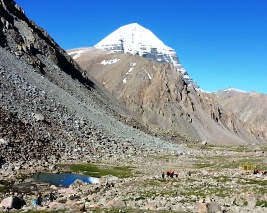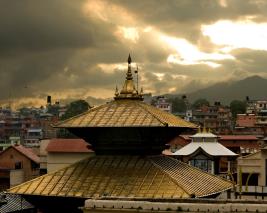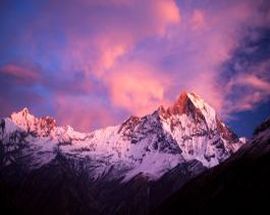The endless blue skies, placid lakes and glorious mountains will leave you awestruck. Warm and friendly faces smiling back at you will make you feel like you have returned home after a long exile. The beautiful spread of stars twinkling in the night sky will fascinate your kids more than the lit-up screens that their eyes are otherwise always glued to. Nepal will awaken the nature-lover in you and reveal its many shades, leaving you dazzled. It will force you to move away from your daily distractions and jump into the arms of nature.
Ready to take the plunge? We, at Thomas Cook, will make sure you land on your feet by helping you choose when to take the big step. Each season in Nepal has something different to offer. Here, we have for you all the information that you may require in order to choose the most ideal time to travel. Listed for you are also the precautions that you must take before and while you are on your trip.
Take a look!
Peak Season – October to November
Shoulder Season – March to May
Low Season – June to September
|
Travel Seasons
|
Min/Max Temperature
|
Season
|
|
March-May
|
8-28°C
|
Warm
|
| June-September |
19-27 °C
|
Sunny and hot days
|
|
October-November
|
18-22°C
|
Slightly cooler
|
|
December-February
|
3 to 19C
|
Cold winds
|
Nepal in Autumn (October-November)
Temperature - The air temperature during the season of autumn fluctuates between 18°C and 22°C.
Weather: The earthy smell of autumn fills your senses as you take in the view of the clear, blue skies above you. Slightly cool winds knock at the door, suggesting the onset of the winter season. With the sun kissing your skin during the day and the cold snuggling next to you as night falls, Nepal in autumn is a comfortable affair. However, this season calls out to all the adventure enthusiasts out there who can never get enough of the greens. This is the best time to visit Nepal if you wish to hit the trails especially in the Everest and Annapurna areas.
Significant events: As the season of mellow fruitfulness covers the grass with a carpet of gold and red shades, tourism is at an all-time high. Caresses of cold winds greet your face in the morning preparing you for the winter season. This is the most suitable time for you to venture outdoors and acquaint yourself with the surroundings. However, this season comes with its own share of festivals and celebrations. The main highlight of this season is the eight-day-long Indra-Jatra festival, celebrated to show gratitude to Lord Indra for blessing them with rains. Celebrated in the month of September, locals dance around donning masks to the sound of loud drums and is one of the most cherished festivals of the Newari community. Another significant festival celebrated in the month of October is Dashain which is better known as Dashera in several other parts of India. Known as the harvest festival, this time of the year is all about family get togethers, exchanging gifts and distributing sweets. Dashain is recognised as the longest festival in Nepal, lasting over two weeks.
Why you should visit now: This time of the year is buzzing with activity with it being the peak season. If you want to witness the mighty mountains in all their glory, this season gives you a crystal-clear view of the same. Autumn is also home to a number of festivals and activities that brighten up Nepal post monsoon. The clear skies and pleasing weather give way to various trekking routes such as Upper Mustang, Everest and Annapurna regions as well as the Langtang region.
Things to know before the visit: Keep your eyes on the road while travelling as the rain gods bid goodbye, leaving the mid-hills of Kathmandu and Pokhara wet and slippery. Also, be mindful of the fact that landslides may block access to certain trekking routes. Hence, try to head to well established trails with reliable infrastructure such as in the Everest and Annapurna regions.
Tips: Since this is the peak season, ensure that your tickets are booked well in advance. Plan your activities and itinerary according to the weather. While you pack, make sure you include both warm and cool clothes as well as sunscreen and some glasses.
Nepal in Spring (March-May)
Temperature: The air temperature during the season of spring ranges between 8°C and 28°C.
Weather: Nepal in Spring is all about blooming rhododendrons, comfortable weather and pristine lakes. Offering a bed of colours dotted with different shades, Nepal dons all kinds of moods in the spring season. This season also meets your outdoorsy demands and is a good time to trek along several trails. The mild chilly air during early spring is a remnant of the winter season. However, the weather gradually gets warmer as the season proceeds.
Significant events: Along with blossoming flora and a picture-perfect view of towering mountain peaks; Nepal in Spring offers a plethora of activities and festivals that lighten up the atmosphere. One such festival celebrated between the months of April to May is Buddha Jayanti. This is celebrated in lieu of Lord Gautam Buddha’s birthday. Locals are clad in white attires and make their way to common viharas to observe the Buddhist Sutra. The highlight of this festival is the kheer that is prepared and served to narrate the story of Sujata who made this sweet milk porridge for Lord Buddha. Another festival that is celebrated is the Nepali New Year on April 14. Locals take to the streets with joyous dances, songs, parades and of course a lot of food! Quite a few traditional dances and sports are organised during this time of the year too.
Why you should visit now: With the season of spring awakening Nepal with its magnetic beauty and a riot of colours, this holiday destination is a dream during this time of the year. This is also a good time to engage in some hiking to satiate the adventurer in you. Take the Mardi Himal Trek with the starting point in Pokhara Kade. This trail is dotted with reliable tea houses and lodges where you can rest after a long day of adventure.
Things to know before the visit: Do not forget to check the weather reports before booking your tickets and accommodation. Since spring still borders the peak season, book your tickets well in advance. Book a hotel that is centrally located, accessible and has a central heating system since the nights could get chilly.
Tips: Do carry a lightweight jacket if you plan to travel in the beginning of the spring season. Carry summer clothes and a sunscreen and some shades in case you are travelling later in the season.
Nepal in Winter (December-February)
Temperature: The air temperature during the season of winter fluctuates between 3°C and 19°C.
Weather: The weather of Nepal in winter can best be described in two words – timeless beauty. With frozen streams and lakes while the rest of the country is bathed in sheets of white; time seems to stand still as winter arrives. The cold winds bite at your skin, sending a shiver down your spine, immediately making you reach out for that hot cup of tea or coffee. However, if you feel that a little cold never harmed anyone and wish to take up a challenge, try out the few winter treks frequented by tourists. You might also bump into a wild deer during this time!
Significant events: Not even the chilly winds or the teeth-chattering cold can dampen the spirit of Nepal. Winter in Nepal calls for an assortment of festivals and celebrations, attracting tourists from all over the globe. However, if you are a film enthusiast, you must head to the Kathmandu International Film Festival that takes place every December. Various aspects of mountain life are presented and celebrated as a part of the agenda of this festival. It comprises a diverse range of screenings, lectures and workshops.
Why you should visit now: If you would rather go for the road less travelled by, this is the best time to visit Nepal. The nature remains untouched by the rush of the tourists at this time of the year as you and your family remain undisturbed. There are also a number of treks such as the Ghorepani Trek and the Chisapani Nagarkot Trek, if you are up for a challenge.
Things to know before the visit: Do check for discounts that may be available at this time of the year since this is the off season. Plan your activities and itinerary keeping the weather in mind. Beware of frostbites and altitude sickness while travelling or trekking.
Tips: Carry woollens at all times to keep yourself warm as cold winds prevail in this region.
Nepal in Summer (June-September)
Temperature - The air temperature during the season of summer ranges between 19°C and 27°C.
Weather – The weather of summer in Nepal comprises humidity, regular rain showers with occasional thunderstorms. The frequent rain showers make Nepal look like a brand-new country, giving it an element of novelty.
Significant events – Along with the many options for sightseeing and trekking activities, Nepal in summer has a number of festivals and events in store for you. One such festival is the Janai-Purnima that celebrates love and purity. Rather similar to Raksha Bandhan, holy chants and prayers prevail during the Janai ceremony. Kwati- a traditional dish made from nine beans is prepared during this festival.
Why you should visit now – Being the off-season, this is the best time of the year to enjoy some peace and quiet with your family, away from the hustle bustle of the tourists. With it being less crowded, you could also enjoy longer hiking holidays in and around the Upper Mustang and Dolpo area.
Things to know before the visit – With the monsoon season also setting in, be mindful of the weather and the roads you travel by. The monsoon rains often bring landslides with them, hence keep that in mind before setting out for the day. Also, do watch out for discounts as you book tickets and accommodation.
Tips – If you plan to trek, beware of leeches and sticky mud that may pose as a hindrance while walking. Wind cheaters, sunglasses and a mosquito repellent are advised. Hefty hotel discounts prevail and are common at this time of the year, hence make sure you choose a good one with a central location.
If you are intrigued and tempted to pack your bags right away, visit our website and go through the Nepal packages that we offer. If you have any more questions, you will get the answers that you are looking for on our page. Contact us immediately to book your tickets and accommodation immediately!











































